Library of Congress's Blog, page 189
April 13, 2012
Not So Secret Garden
One of the things I love most about going home to southern Mississippi is going home to my mom’s garden. The sights and smells are always like a big, warm hug. The jasmine she’s got growing on a trellis is a focal piece. The calla lilies lining one side of the yard are some of her prized flowers. Louie the bougainvillea (my mom likes to name her plants, this one after its namesake Navy admiral and explorer Louis Antoine de Bougainville) brings a traditional southern flair to her yard. And let’s not forget all her “accents” – her statuary of St. Michael and St. Francis, the bricked patio that she and my dad hand-laid themselves and, last but not least, her collection of rocks she “rescued” from her and dad’s many travels. All of these things come together to create a warm refuge that clearly shows the love put into it.
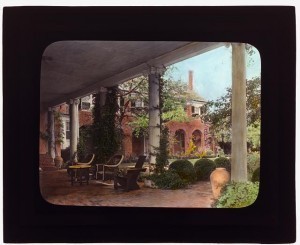
Malcolm Matheson house, Fox Hunt Road, Alexandria, Va. Lantern slide by Frances B. Johnston, 1927 / Prints and Photographs Division
The Library of Congress today is releasing online the digital images of a rare collection of more than 1,000 hand-colored, glass-plate lantern slides of American gardens taken a century ago by one of the first professional female photographers to achieve international prominence, Frances Benjamin Johnston. Johnston last projected them during lectures in the 1910s to 1930s to rally Americans to grow gardens in an effort to beautify a landscape left neglected and deteriorated from industrial pollution during the Gilded Age. And they have not been seen since, until now.
The absence of garden names, locations and dates had kept these lantern slides from general public access, until historian Sam Watters took it upon himself to catalog the garden collection. After five years of research in libraries and archives, he has transformed vague earlier notations into detailed data.
Through these efforts a book was born. “Gardens for a Beautiful America: 1895-1935: Photographs by Frances Benjamin Johnston,” published by Acanthus Press in collaboration with the Library of Congress, features 250 full-color images and essays that describe the importance of Johnston’s work with gardens and explain the techniques she used to compose lantern slides that resemble delicate miniature paintings.
The Library is the repository of Johnston’s personal papers and some 20,000 of her photographs. She has long been acknowledged as an important photographer for her many contributions to early photojournalism and documentation of historic architecture. These photographs help bring her role in the Garden Beautiful movement as an advocate and artist working with garden clubs, horticultural societies and museums front and center.
Make sure to check out this blog post from the Prints and Photographs Division, which also talks about Johnston and points to related resources for further research.
April 12, 2012
An Unsinkable Legacy: Remembering the Titanic
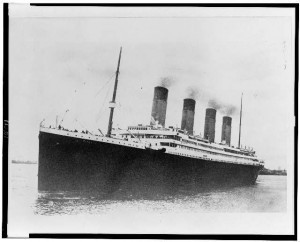
The Titanic / Prints and Photographs Division
In the wee hours of the morning on April 15, 1912, the RMS Titanic – the largest passenger steamship in the world at the time – sank into the depths of the Atlantic Ocean after hitting an iceberg only a few hours earlier. More than 1,500 people died. This year marks the centennial of one of the deadliest maritime disasters in history.
Let me tell you another story about another ship, The Titan, billed as "unsinkable." Setting off across the Atlantic, it also hits an iceberg and goes down. Most of the passengers perish.
The Titan is the story you haven't really heard about or read about in the news and history books – probably because it's a work of fiction. Written by Morgan Robertson in 1898, "Futility" tells a tale eerily similar to that of the Titanic – 14 years before the actual tragedy. Was Robertson unknowingly predicting the future? As it turns out, his fictional ship is almost identical to the real one, including its dimensions and the speed at which it was traveling when it hit the iceberg.
Very few copies of the 1898 edition still exist. (Robertson re-released his book in 1912, following the Titanic sinking, with a new title, "The Wreck of the Titan.") The Library of Congress has a copy in its Rare Book and Special Collections Division; there are other copies in the British Library and a few other private libraries.
You can read the book online here.
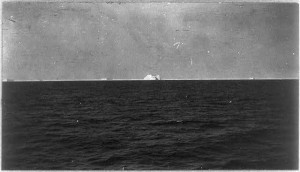
View from the S.S. Carpathia of the iceberg that sank the Titanic / Prints and Photographs Division
Robertson didn't sink the market, as it were, when it came to such predictions. Another eerie coincidence is in W. T. Stead's short story, "From the Old World to the New," published in 1892. In the story, a White Star Line vessel, The Majestic, rescues the passengers of another ship after a collision with an iceberg. Strangely enough, Stead himself would go down with the Titanic 20 years later.
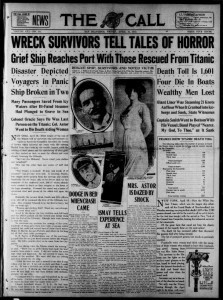
The San Francisco Call. April 19, 1912
As far as the actual facts go, the Library has many primary sources on the Titanic. With headlines like "Queen of the Sea's Awful Fate on Her First Trip Out," "Death in Husband's Arms Better Than Life Alone for These Heroines of the Titanic," or "Wm. T. Stead, 'Titanic' Victim, is Sending Messages From Spirit Land" the Library's Chronicling America newspaper collection brings you the news of the tragedy. More sample article and search suggestions can be found here.
Speaking of newspapers, as publications mark the Titanic centennial, you may be seeing lots of old photographs of the ship and such. Some of those are coming from the Library's own photograph collections. From images of its construction and interior design to views of the ship on its first and final voyage to survivor portraits, knowing the ultimate outcome of the Titanic makes looking at these pictures all the more haunting.
As the Titanic went down, it's said that the ship's musicians played to the bitter end in an effort to maintain calm during the evacuation. According to survivor accounts, the hymn "Nearer My God To Thee" was the song they played. You can hear a version of it in the Library's National Jukebox.
This really is just a sampling of the related resources on the Titanic. Several of the other Library blogs are also marking the anniversary. Make sure to check them out for more fascinating stories.
April 11, 2012
New and Improved
The Library of Congress is constantly in the process of improving its products and services to better assist its patrons, friends and researchers. Recently we launched a series of updates to the website, enabling users to find and use our online materials more easily.
The Library's main web search function has been improved. A new feature allows users to narrow their search results by language and location. In addition, the homepage and search-results pages have updated search boxes that allow users to refine their search by format, such as books, photos and maps.
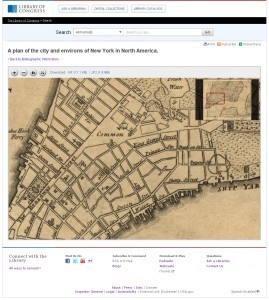
Detail from a map of New York, 1776 / Geography and Maps Division
Speaking of maps, the Library has implemented a new "object" page – initially limited to some 9,500 maps from the Geography and Maps Division – that present material in a cleaner, simpler layout. An improved zoom feature lets you better examine the finer details of the map images, including a "full screen" view. And, you can take your map "on the go," as it were, thanks to better mobile-device functionality and the now-Library-standard features such as social-media sharing.
Most of these maps are in the new template.
Additional collections will be changed to the new template over the next several months.
Other improvements include better use of metadata and expanded links to related material.
You can access the new features at www.loc.gov/search or use the search box found of most web pages in the upper right-hand corner.
April 10, 2012
Last Chance to See "Creating the U.S."
On May 5, the Library will close its popular exhibition "Creating the United States." The exhibition has been on view for four years and seen approximately 2 million visitors passing through its space. Pulitzer Prize-winning historian David McCullough once called it the one exhibition every American should see on a visit to Washington, D.C.
Notable items on display include Thomas Paine's "Common Sense," James Madison's notes from the 1787 Constitutional Convention (June 18, 1787), Madison's Copy of the Federalist's Papers and Thomas Jefferson's Second Inaugural Address (March 4, 1805).
Although it was moved for preservation reasons, Thomas Jefferson's handwritten draft of the Declaration of Independence, with edits by his fellow founding fathers John Adams and Benjamin Franklin, held a place of prominence during the exhibition's inaugural months. There are interactive displays showing where some of its central tenets came from.
Of course, you can see all these materials and more online, including interactives that allow you to delve deeper into the creation of these cornerstone texts. But, trust me, there's nothing quite like seeing them in person and sharing the same space, however briefly. So, if you're in town, make sure to visit or revisit this landmark exhibition before it's gone.
Last Chance to See “Creating the U.S.”
On May 5, the Library will close its popular exhibition “Creating the United States.” The exhibition has been on view for four years and seen approximately 2 million visitors passing through its space. Pulitzer Prize-winning historian David McCullough once called it the one exhibition every American should see on a visit to Washington, D.C.
Notable items on display include Thomas Paine’s “Common Sense,” James Madison’s notes from the 1787 Constitutional Convention (June 18, 1787), Madison’s Copy of the Federalist’s Papers and Thomas Jefferson’s Second Inaugural Address (March 4, 1805).
Although it was moved for preservation reasons, Thomas Jefferson’s handwritten draft of the Declaration of Independence, with edits by his fellow founding fathers John Adams and Benjamin Franklin, held a place of prominence during the exhibition’s inaugural months. There are interactive displays showing where some of its central tenets came from.
Of course, you can see all these materials and more online, including interactives that allow you to delve deeper into the creation of these cornerstone texts. But, trust me, there’s nothing quite like seeing them in person and sharing the same space, however briefly. So, if you’re in town, make sure to visit or revisit this landmark exhibition before it’s gone.
April 6, 2012
The National Book Festival – Be There, Sept. 22-23
Heads up, all you fans of the Library of Congress National Book Festival – it's going to be two days again this year, with more than 100 authors, following last year's successful launch of the full-weekend approach.
The festival will be held on the National Mall between 9th and 14th Streets on Saturday, Sept. 22, 2012, from 10 a.m. to 5:30 p.m. and on Sunday, Sept. 23 from noon to 5:30 p.m., rain or shine. As in all its 12-year history, the event will be free and open to the public.
The delightful Rafael López, whose work summons imagery of Mexican street life, surrealism and myths, is this year's artist for the festival commemorative poster.
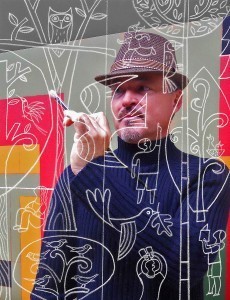
Rafael López, a man seen (and seeing) through his art
His illustrations for "Book Fiesta!" written by Pat Mora, won the 2010 Pura Belpré Illustrator Award.
Additional festival-related events will take place in the days and weeks preceding the much-anticipated yearly gathering, which celebrates the joys of books and reading. More information, including authors who will attend, will be posted as planning for the festival continues at the festival's website.
The 2012 Library of Congress National Book Festival will feature award-winning authors, poets and illustrators in several pavilions dedicated to categories of literature. Festival-goers can meet and hear firsthand from their favorite authors, get books signed, have photos taken with mascots and storybook characters and participate in a variety of learning activities.
Here's a sampling of one of the popular children's events launched at last year's festival: the Okee Dokee Brothers (Joe Mailander and Justin Lansing), singing on the Family Storytelling Stage sponsored by Target, one of the festival's longest-term sponsors.
More author talks and performances for kids from last year's festival can be found here.
Who are the authors and illustrators you'd like to see at the 2012 Library of Congress National Book Festival?
Today in History: U.S. Enters World War I
From time to time, I'd like to blog about notable historical events or otherwise interesting advents in our nation's past, courtesy of Today in History, which mines the American Memory collections to discover what happened in our nation's history on each date throughout the year.
Today's "TIH" marks the day in 1917 the United States entered World War I. The immediate cause of America's entry into the war was the German announcement of unrestricted submarine warfare and the subsequent sinking of ships with Americans on board.
American troops arrived in France at the rate of 10,000 a day. More than 2 million U.S. troops were deployed through the course of the conflict. Among those American troops was Cpl. Frank Buckles, who was the last known World War I veteran until he passed away last year at the age of 110. His oral history collection is part of the Library's Veterans History Project (VHP). As a tribute, its "The Great War" presentation provides a virtual tour of some of the most compelling collections in VHP archives and features stories of nearly two dozen men and women who served in WWI.
On Nov. 1, 1918, an armistice was signed, ending the war.
Further resources on this important day in history can be found here.
April 3, 2012
Read Poets Society
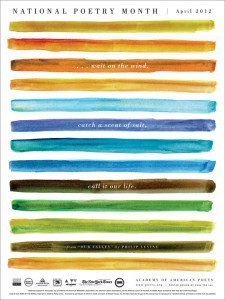
2012 National Poetry Month poster featuring "Our Valley" by Philip Levine / Chin-Yee Lai
April marks National Poetry Month, a time for poets and lovers of poetry everywhere to unite, recite and delight in the art and in those who have created it. The annual commemoration was inaugurated in 1996 by the Academy of American Poets.
Some of my favorite poets include Byron, Tennyson, Yeats and Neruda. And I plan to make sure to dig out some of their best-loved verses to commemorate the month. How about you? Who will you be reading?
The Library does much to celebrate thanks to its own Poetry and Literature Center. On tap this month are a slew of events, including an April 4 reading by this year's winners of the Library of Congress's Witter Bynner Fellowship, an April 13 reading by Japanese-American poet Garrett Hongo and the ever-popular Shakespeare's birthday celebration on April 18. (Webcasts of these events should be available on our site in the coming weeks.)
Established in the 1940s, the Poetry and Literature Center has been almost exclusively supported since 1951 by a gift from the late Gertrude Clarke Whittall, who wanted to bring the appreciation of good literature to a larger audience. The center administers several prestigious prizes in poetry and also sponsors an active series of public poetry and fiction readings, lectures, symposia and other literary events in addition to its full April schedule.
Make sure to also check out its blog, From the Catbird Seat, to stay updated on the latest musings.
The Library's website is also an excellent resource for American poetry. The Poet Laureate of the United States (currently Philip Levine) is chosen by the Librarian of Congress, and the holder of the position maintains an office on the top floor of the Library's Thomas Jefferson Building. Levine will actually be on hand to introduce the Witter Bynner fellows at the April 4 event.
While I could list enough to fill several blog posts, I'll point you to this handy resource guide that offers a comprehensive list of the various poetry resources available on the Library's site.
March 28, 2012
See It Now: A Bully President
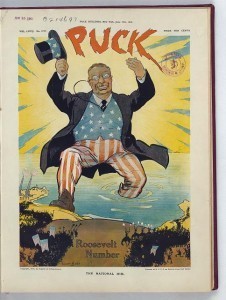
The national him / Gordon Ross. June 15, 1910. Prints and Photographs Division.
A Nobel prizewinner, a paleontologist, a taxidermist, an ornithologist, a field naturalist, a conservationist, a big-game hunter, a naval historian, a biographer, an essayist, an editor, a critic, an orator, a civil-service reformer, a socialite, a patron of the arts, a colonel of the cavalry, a ranchman … the list goes on. Add to that the 26th president of the United States, and you've got Theodore Roosevelt.
Teddy was a beloved figure in American politics and a favorite subject of political cartoonists. His exuberance, larger-than-life personality and exploits lent themselves perfectly to the medium. As author Rick Marschall has stated, "Presidents were boring up until Roosevelt and boring after him."
Marschall was on hand at the Library late last year to discuss his new book, "Bully! The Life and Times of Theodore Roosevelt," the webcast of which is now available. You can watch it below.
The Library's collection of political cartoons includes a variety of Roosevelt-related items, many coming from Puck, America's first successful humor magazine. Roosevelt was favored on the cover more than 80 times in his career.
The youngest president at age 42, Roosevelt was also the first to have his life and career chronicled on film. The Library's online presentation includes a selection of 87 motion pictures that represent different times and phases in his life.
Perhaps one of the most bully boons in the Library's presidential collections are the papers of Teddy Roosevelt. Numbering some 250,000 items, they constitute one of the largest among our presidential holdings. While plans for future digitization are still being made, selections from his diaries can be see here.
Wait, there's more. Scattered throughout the institution's various American Memory collections, online exhibitions and other resources are assets pertaining to TR, all collected in this handy guide.
March 26, 2012
Braille Music Scores Provide Lifeline to Blind Musicians
(The following is a guest article about the Braille music collections of NLS and the musicians who use them written by my colleague Mark Hartsell , which recently appeared in the Library's staff newsletter, the Gazette.)
Ayaka Isono lost her sight to a rare retinal disorder in 2001 at age 29 and, devastated, figured her career as a pianist was over.
"I couldn't see the score, I couldn't work with conductors, I couldn't play ensembles, I couldn't write new music," says Isono, who performed in chamber groups with some of the top players in the country and occasionally performed with the San Francisco Symphony and Oakland Ballet Company.
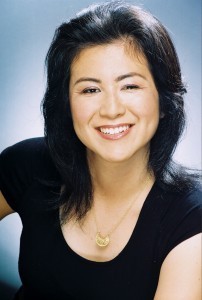
Ayaka Isono
Depressed, she didn't touch her piano for three years. She never played, never went to concerts, never listened to music.
Now, Isono performs again, using braille music scores for solo piano and chamber ensembles that she downloads and prints at home. She teaches, too, using braille instructional material.
Isono is one of thousands of visually impaired musicians whose work depends upon the collections of the Music Section of the National Library Service for the Blind and Physically Handicapped (NLS), a program of the Library of Congress.
"I can't imagine my career without them. I really can't," says Isono, a native of Japan who now lives in the Bay Area. "I get so many materials from them."
World's Biggest Collection
The music collections at NLS represent the world's largest source of material for visually impaired musicians and music lovers – more than 30,000 braille transcriptions of musical scores and instructional texts; large-print scores, librettos, reference works and biographies; instructional recordings in music theory, appreciation and performance; and talking books and magazines.
Each year, the Music Section fills between 2,500 and 3,000 requests from a wide range of people who suffer from blindness or low vision – professional players seeking scores to perform, blind students or teachers in need of instructional material, or aficionados who just want a good book about a favorite musician.
Very few sources exist around the world for braille musical scores and instructional texts, says John Hanson, head of the Music Section.
NLS commissions many braille transcriptions of scores and instructional material – such commissions represent about half of its acquisitions each year. Libraries for the blind in Italy, Great Britain and Switzerland, for example, also commission material, and NLS makes the balance of its acquisitions each year from such institutions.
"They regularly add to their music collections, and I buy them whenever I can," Hanson says. "Otherwise, there is really no where else to turn."
Still, much more material is available today than in decades past.
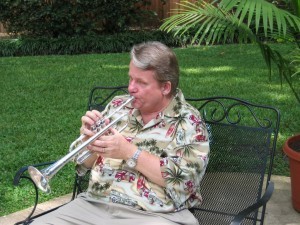
Paul Kurtz
Paul Kurtz, a retired counselor and computer programmer who was blind from birth, first took up the trumpet as a seventh-grader in the mid-1960s.
At the time, he could find only one braille instructional text for his chosen instrument, a 1933 Arban method book he got from NLS.
The dearth of material – even through the 1970s and '80s – discouraged him from pursuing a music career. The time he spent tediously transcribing braille music and text for his own use cut into the time he would have spent teaching or playing.
"It hindered any professional aspirations I had toward teaching," says Kurtz, who today plays with several bands in his native Jacksonville, Fla.
Though NLS will have specific pieces transcribed on request, Kurtz and other musicians often pay to have pieces and texts transcribed into braille and donate them to the Music Section – an effort to ensure future generations of visually impaired musicians have the material they need.
Kurtz alone has paid for the transcription of more than 20 method books.
"I stand on many long-suffering shoulders of people who got us to here," he says. "That's why I don't mind doing my part in the braille music for trumpeters project. The Library is the fountainhead and the producing engine for all of the future efforts to come out, in braille, large print and audio."
A Lifeline for Musicians
That material provides an important resource for blind musicians trying to adapt to their impairment, learn their craft or make it in the business of music.
Jessica Bachicha was born blind, took her first music lessons at 12 and decided as a teenager to pursue a career in music.
But Bachicha, a soprano, didn't know music theory or read braille music. Instead, she just memorized everything. A session at a music institute in Connecticut showed her the limitations of that approach.
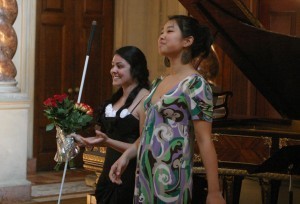
Soprano Jessica Bachicha (left) and pianist Choo Choo Hu performed a program of Spanish songs at the Anderson House in the District./Mark Hartsell
"I went into my first jazz piano class and was completely left in the dust," says Bachicha, a native of New Mexico. "I was in tears by the end of the class because I had no idea. That really inspired me to learn theory. I was like, 'Oh, my gosh, this is a whole new world."
Part of that new world was learning to read braille music. A teacher told her of the collections at NLS, and Bachicha began to make use of its braille instructional texts, histories and scores.
Inspired, she earned a bachelor's degree in music from the University of New Mexico, a master's at the New England Conservatory and a doctorate at Catholic University.
Having a source of braille musical material at NLS helped her develop as a musician in ways she otherwise couldn't, Bachicha says.
"When I went off to college it was a lifesaver in my theory classes, in my history and in my voice classes," she says. "I began to learn a lot more volume of material as well."
Bachicha now works part time at the National Federation of the Blind in Baltimore while she pursues music.
In recent years, she played the Queen of the Night in Mozart's opera "The Magic Flute" at Catholic University and Violetta in Verdi's "La Traviata" with the Bel Cantanti opera company. In January, she made her New York debut at Carnegie Hall.
The biggest challenge now, she says, is convincing people not to be afraid of her blindness and to give her a chance in what already is a highly competitive field.
"I'm still waiting for that conductor to come along," Bachicha says. "It's just waiting for somebody who can not only say, 'Oh, yeah, I think you can definitely do it," but somebody who can say, 'I know you can do it and I'm going to pay you to do it.' "
Access Better than Ever
Advances in technology make it easier than ever for visually impaired musicians such as Bachicha, Isono and Kurtz to access material.
At one time, the Music Section offered only a limited number of hard copies of braille scores that would be mailed to patrons around the country – a problem if the music was already checked out or if a patron needed a piece quickly.
Now, about 10 percent of the collection – and growing each year – is digitized and available via download.
The Library's Web-Braille format makes braille music scores, for example, available in an electronic format via the Internet. Patrons can download a score and either read it with a braille display device or print a hard copy with a braille printer.
Portable braille "note-taker" devices allow the musicians to store entire music libraries and transport them to use during rehearsals or classes.
"It is better today, and it is getting better by leaps and bounds," Kurtz says.
All this was new to Isono when she lost her sight – she didn't know any blind people, had never even heard of braille music.
But a teacher who taught her to read braille text also told her about braille music. That led her to the collections at NLS and, eventually, back to her place at the piano.
"I told myself, 'I can do this. I can read braille music,' " Isono says. "I didn't expect myself to be back in this professional music field again. It really feels good to do full-time music again."
Library of Congress's Blog
- Library of Congress's profile
- 74 followers



